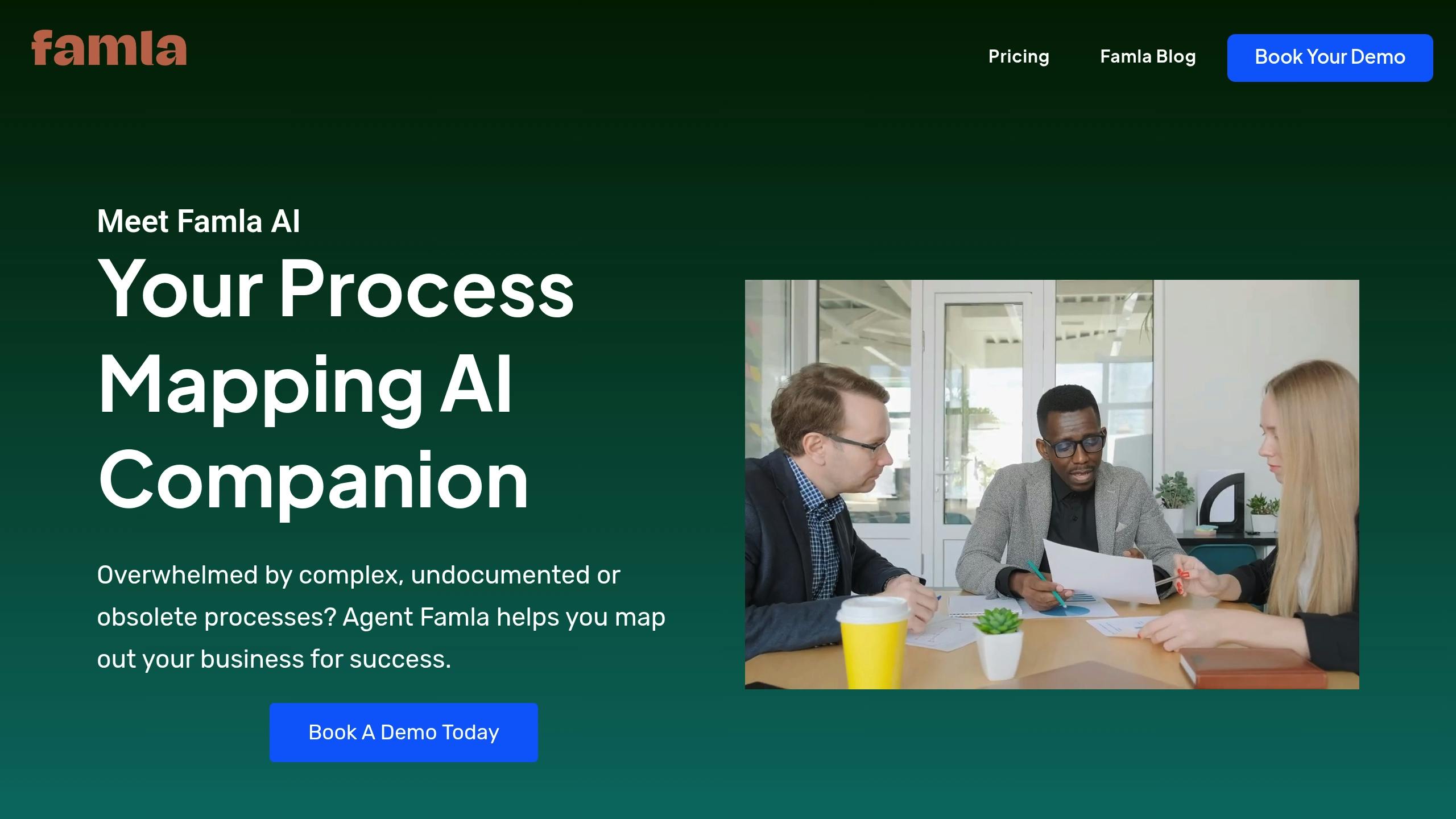AI process mapping transforms how businesses optimize workflows by automating data collection, analysis, and visualization. It replaces manual methods with faster, more accurate tools that adapt in real time, identifying inefficiencies and delivering actionable insights. Here’s what you need to know:
- What it does: Automatically maps processes using data from systems like ERP, CRMs, and IoT devices.
- Key benefits: Cuts production cycles by 30%, lowers operational costs by 25%, and improves efficiency by 30-50%.
- Core methods: Uses process mining, machine learning, and real-time updates for dynamic insights.
- Comparison: AI mapping is faster (2-3 days vs. weeks), more accurate (95-99%), and scalable compared to manual methods.
- Real-world examples: Toyota improved production by 35%; Mayo Clinic cut patient wait times by 22%; JPMorgan Chase increased compliance efficiency by 28%.
AI process mapping is a game-changer for industries like manufacturing, healthcare, and finance, offering measurable improvements in speed, cost, and accuracy. Let’s dive into how it works and how you can get started.
Meet Famla: The AI That Automates Process Mapping

Core Functions and Methods
These functions rely on three interconnected systems that transform raw data into useful insights.
Data Collection Methods
AI process mapping starts by collecting data through these main approaches:
- System Integration: Direct links to enterprise systems.
- Log Analysis: Extracting information from digital activity logs.
- IoT Sensors: Monitoring physical assets in real time, especially in manufacturing and logistics[3][8].
This automated data collection sets the stage for the next phase - intelligent analysis.
AI Analysis Techniques
The analysis phase uses several techniques to make sense of the collected data:
| Technique | Purpose | Outcome |
|---|---|---|
| Process Mining | Creates models of real workflows based on system records | Identifies deviations from expected processes[1][5]. |
| Machine Learning | Finds patterns in historical data | Predicts bottlenecks and inefficiencies[3][8]. |
| Natural Language Processing | Examines text-based documentation | Extracts insights from unstructured data[2][5]. |
| Pattern Recognition | Spots irregularities | Points out areas for improvement[1][3]. |
Real-Time Updates
For smaller businesses with limited resources, real-time monitoring removes the need for manual tracking by offering:
- Version control: Keeps a record of historical changes[3].
- Instant alerts: Notifies users of unexpected process changes[2][5].
The system integrates data from multiple teams, mapping critical dependencies and ensuring seamless operations across different sources[1][3][8].
AI vs Manual Process Mapping
AI-based process mapping offers clear advantages when compared to traditional manual methods:
Comparison Matrix
| Aspect | AI Process Mapping | Manual Process Mapping |
|---|---|---|
| Mapping Speed | 2-3 days per complex process | 2-4 weeks per complex process |
| Accuracy Rate | 95-99% | 60-80% |
| Process Variations Identified | Dozens, including rare exceptions (<1%) | 3-5 main variants |
| Data Processing Capacity | Scalable to unlimited data | Limited to 100-1,000 instances |
| Update Frequency | Real-time or daily updates | Monthly or quarterly updates |
| Initial Investment | $10,000-$50,000 | $2,000-$10,000 |
For businesses with tight budgets, these differences translate into real financial advantages.
Cost Benefits for SMEs
While the upfront cost of AI process mapping may be higher, the long-term savings and efficiency gains are undeniable. Small and medium enterprises (SMEs) can benefit through:
- A 50-70% reduction in costs with a break-even period of 12-18 months [4][6].
- 40-60% lower overall mapping expenses and a 200-300% return on investment (ROI) within two years of implementation [6].
- A 30-50% cut in audit-related costs by improving compliance tracking.
Take Siemens Energy as an example. By adopting AI, they reduced a three-month analysis process to just two weeks, analyzed 250,000 process instances, and uncovered €15 million in savings. They also increased operational efficiency by 22%.
As highlighted in earlier metrics, AI consistently identifies 30-40% more improvement opportunities than manual approaches while ensuring compliance with changing regulations [9].
sbb-itb-bec6a7e
Industry Examples
Manufacturing Examples
Toyota has leveraged IoT sensors (as detailed in the Data Collection section) to optimize its assembly line workflows. By incorporating AI-driven process analysis, the company reduced bottlenecks by 35%, boosting daily vehicle production from 2,000 to 2,600 units [1]. This highlights how integrating AI with real-time sensor data can streamline operations.
Another example comes from a global electronics manufacturer. By using AI to map their supply chain processes, they reduced inventory costs by 18% and improved on-time deliveries by 25% [2]. The system achieved this by forecasting inventory needs based on historical trends and market dynamics.
Healthcare Applications
AI's impact extends beyond factories to healthcare, where it enhances patient care and operational efficiency. For instance, the Mayo Clinic improved staff scheduling by analyzing schedules and resource availability with AI-driven tools. This led to measurable improvements:
| Metric | Improvement |
|---|---|
| Average Patient Wait Times | 22% reduction |
| Daily Patient Throughput | 18% increase |
Additionally, hospital networks using AI-powered scheduling systems saw a 17% drop in surgery cancellations and a 23% boost in operating room usage [3]. These results align with the efficiency gains of 30-50% often cited for small and medium-sized enterprises (SMEs).
Financial Compliance
In the financial sector, AI supports compliance by enabling faster and more accurate decision-making. For example, JPMorgan Chase used AI pattern recognition to cut false positives by 42% and improve compliance efficiency by 28% [7].
Another financial institution automated its Know Your Customer (KYC) processes with AI, achieving onboarding times of just 6 hours while maintaining 99.9% compliance accuracy. This was made possible through continuous AI-based verification [10].
Tool Selection Guide
Implementing AI process mapping successfully depends on choosing tools that fit your organization's current needs and long-term goals.
Must-Have Features
When picking an AI process mapping tool, focus on features that match your business priorities. Look for capabilities like automated process discovery and real-time analytics. Cloud-based tools can be especially helpful for teams with limited resources [2][4].
Here's a breakdown of typical pricing tiers:
| Feature | Entry-Level ($50-200/month) | Enterprise ($500-2000/month) |
|---|---|---|
| Process Discovery | Basic automated mapping | Multi-department workflow tracking |
| Data Integration | Limited API connections | Full system integration |
| Analytics | Standard reporting | Predictive analytics |
| Security | Basic encryption | Advanced compliance controls |
Available Tools
The global process analytics market is expected to grow significantly, reaching $1,421.7 million by 2026 [5]. Several tools have emerged as top choices in this space. For example, Signavio Process Intelligence is a standout option for small and medium-sized enterprises (SMEs), helping businesses improve process efficiency by an average of 61% within six months of implementation [12].
When comparing platforms, keep these factors in mind:
- Integration Capabilities: Opt for tools with pre-built connectors for widely used business systems [2][4].
- Scalability: Ensure the solution can grow with your business - from mapping a few core processes to managing 15-20 workflows as your needs expand [2].
- Support and Training: Look for vendors that offer onboarding assistance and ongoing support [7].
For businesses exploring AI-powered process optimization, AI for Businesses provides tailored comparisons of tools designed for different industries and budgets. This resource can be particularly helpful for those seeking affordable ways to get started.
Conclusion
Main Points
AI process mapping has shown its value across industries like manufacturing, healthcare, and finance. By focusing on areas such as production optimization, patient flow management, and compliance tracking, organizations have reported efficiency improvements of 30-50%, as highlighted in various case studies. These results are driven by AI's ability to handle tasks like automated data collection, predictive analysis, and creating adaptable models.
Getting Started
If you're ready to implement AI process mapping, here’s how to approach it:
- Assessment and Planning: Begin with a targeted pilot project. Organizations using this strategy tend to adopt AI tools more quickly [6]. Pick a process that has a major impact, as identified during your initial analysis.
- Tool Selection and Integration: Find a tool that matches your organization's specific needs [11]. Make sure it integrates well with your existing systems.
- Implementation and Training: Train your team to use the tool effectively. Companies that focus on training often see a 35% higher adoption rate [3]. Use the integration features of your chosen tool to ensure a smooth transition.
Regular monitoring is key to sustaining improvements. This ongoing process helps maintain the competitive edge discussed throughout this guide.
FAQs
Can ChatGPT help with process mapping?
Yes, ChatGPT can assist in process mapping by recommending formats like flowcharts or swimlane diagrams. It can also help outline key process steps, identify critical data points, and organize the structure for process documentation effectively [1].
For small and medium-sized businesses looking for cost-effective options, ChatGPT's insights can be paired with process mapping tools. These tools create visual workflows and integrate with existing systems. Platforms like AI for Businesses provide curated options tailored for such needs.
How do you use AI for process mapping?
Here’s a simple approach to using AI in process mapping:
- Define the scope: Set clear boundaries for the process and identify key metrics using AI tools.
- Collect data: Automate data gathering from your systems to ensure accuracy.
- Analyze the process: Use AI to uncover patterns and understand relationships within the process.
- Create the map: Leverage AI-powered tools to visualize the workflow.
- Implement changes: Apply AI-driven recommendations to improve the process.
- Monitor continuously: Track the impact of changes and refine as needed [2].
Are there AI tools for process mapping?
Yes, several AI-driven tools specialize in process mapping. Here are a few:
| Tool | Key Features |
|---|---|
| Celonis | Automated process discovery |
| UiPath Process Mining | Integration with RPA tools |
| ABBYY Timeline | Real-time process monitoring |
These tools provide features like automated discovery, real-time analytics, and actionable recommendations to streamline workflows. For more details on selecting the right tool, refer to the Tool Selection Guide mentioned earlier.


